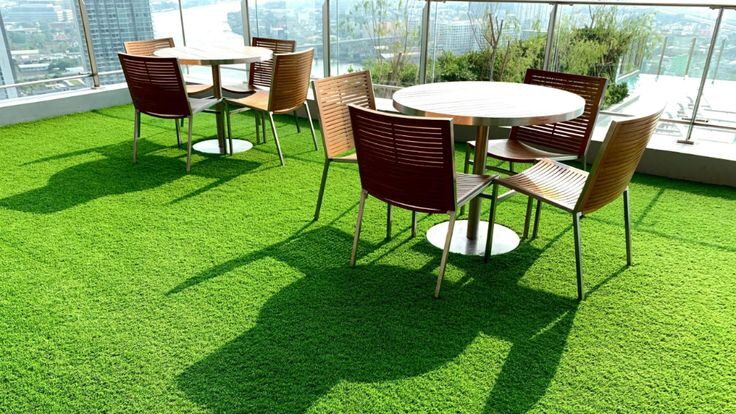
Installing Artificial Grass on Your Balcony
Transforming your balcony into a green oasis with artificial grass is a fantastic way to add a touch of nature to your living space. Whether you’re considering astro turf for your balcony or a more traditional grass carpet, this guide will walk you through everything you need to know about choosing, installing, and maintaining synthetic grass for your balcony.
Why Choose Artificial Grass for Your Balcony?
Low Maintenance
One of the biggest benefits of using artificial grass on a balcony is the low maintenance it requires. Unlike natural grass, which needs regular watering, mowing, and fertilizing, faux grass for a balcony stays green and lush year-round with minimal effort.
Aesthetic Appeal
Artificial turf for a balcony offers a lush, green look that can significantly enhance the visual appeal of your outdoor space. It creates a cozy and inviting atmosphere, making your balcony the perfect place to relax.
Durability
Synthetic grass for balconies is designed to withstand various weather conditions. It’s resistant to wear and tear, making it a durable option that can last for years without needing replacement.
Types of Artificial Grass for Balconies
AstroTurf
AstroTurf is one of the most popular types of artificial grass. It’s known for its durability and realistic appearance, making it a great choice for balcony installations.
Synthetic Grass
Synthetic grass is another excellent option for balconies. It’s softer than AstroTurf and comes in various textures and colors, allowing you to customize your balcony’s look.
Grass Carpet
A grass carpet for a balcony offers a quick and easy installation process. This option is ideal for those who want a temporary solution or are renting their space.
How to Choose the Right Artificial Grass for Your Balcony
Pile Height
When selecting artificial grass for your balcony, consider the pile height. Shorter piles are easier to clean and maintain, while longer piles offer a more natural look.
Material
The material of the grass is also important. Polypropylene is budget-friendly but less durable, while polyethylene offers a good balance between softness and durability.
Color and Texture
Choose a color and texture that match your aesthetic preferences. Some grasses have a more vibrant green, while others mimic the look of natural, slightly worn grass.
Step-by-Step Guide to Installing Artificial Grass on a Balcony
Preparation
Cleaning the Surface
Before installing artificial grass on your balcony, ensure the surface is clean and free of debris. Sweep or wash the area to remove any dirt, dust, or loose particles.
Measuring the Area
Accurate measurements are crucial. Measure your balcony’s length and width to determine how much artificial grass you’ll need.
Laying the Artificial Grass
Cutting to Size
Cut the artificial grass to fit your balcony’s dimensions. Use a sharp utility knife to make clean, precise cuts.
Securing the Edges
Secure the edges of the fake grass for your balcony with double-sided tape or adhesive. This step is crucial to prevent the grass from shifting or curling up at the edges.
Adding Infill
Infill helps to weigh down the grass and keep the blades upright. Use sand or rubber infill for this purpose, spreading it evenly across the surface.
Finishing Touches
After the grass is laid and secured, brush the fibers to lift them and give the turf a more natural appearance. This final touch enhances the overall look of your balcony oasis.
Maintenance Tips for Balcony Artificial Grass
Regular Cleaning
Although artificial grass is low-maintenance, regular cleaning is still necessary. Sweep or hose down the grass to remove dirt and debris.
Brushing the Grass
Brushing the grass regularly helps maintain its upright position and keeps it looking fresh. Use a stiff-bristled brush to do this.
Stain Removal
If you spill something on your balcony synthetic grass, clean it up immediately. Use a mild detergent and water to remove stains without damaging the grass.
Pros and Cons of Installing Artificial Grass on Your Balcony
Pros
- Low Maintenance: Requires minimal care compared to natural grass.
- Year-Round Greenery: Stays green regardless of the season.
- Durable: Can withstand various weather conditions without fading or wearing out.
Cons
- Initial Cost: The upfront cost of installing artificial grass can be high.
- Heat Retention: Artificial grass can get hot in direct sunlight, making it uncomfortable to walk on during summer.
Cost of Installing Artificial Grass on a Balcony
The cost of installing artificial lawn for a balcony varies depending on the type of grass and the size of the area. On average, expect to pay between $5 to $20 per square foot, including installation.
Conclusion
Installing artificial grass on your balcony is a great way to enhance your outdoor space with minimal effort. It’s durable, aesthetically pleasing, and requires far less maintenance than natural grass. By following the steps outlined in this guide, you can create a beautiful, green retreat right outside your door.
FAQs
How long does artificial grass last on a balcony?
Artificial grass can last anywhere from 10 to 15 years on a balcony, depending on the quality of the grass and how well it is maintained.
Is artificial grass safe for pets on a balcony?
Yes, artificial grass is safe for pets. It’s durable enough to withstand pet activities and can be easily cleaned if necessary.
Can artificial grass be installed on a sloped balcony?
Yes, artificial grass can be installed on a sloped balcony, but additional securing methods, such as adhesive or nails, may be required to prevent sliding.
How do I clean artificial grass on a balcony?
To clean artificial grass on a balcony, regularly sweep away debris and rinse with water. For stains, use a mild detergent and water mixture.
Does artificial grass get hot on a balcony?
Artificial grass can get hot in direct sunlight, but choosing a lighter color and using an infill that reflects heat can help mitigate this issue.
